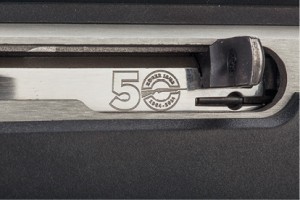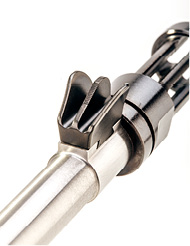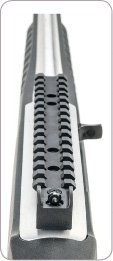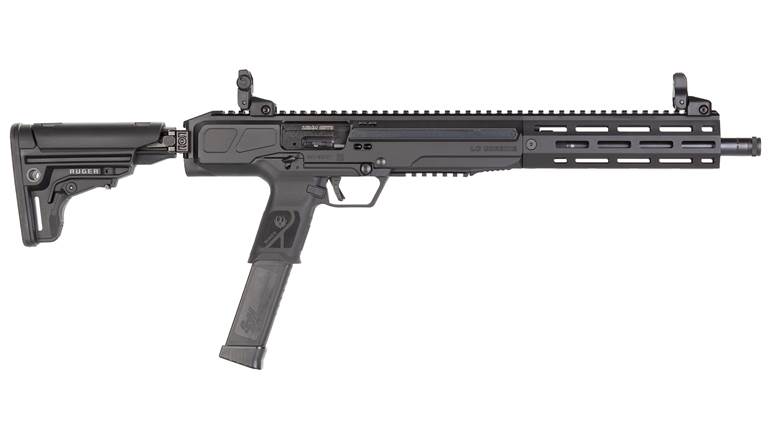
“I have just received this proof of our new catalogue page and rush it to you herewith, because I hope you are going to be somewhat intrigued by our efforts to make a .22 rifle which avoids all the usual banalities—I am also sending this folder to other publications today and this represents our first release of information concerning this. I really think we have been successful in this and from a technical point of view, the new 10/22 is one of the best things we have done. We are planning to show the gun at the N.R.A. Show, but will not announce it in our advertising until June. We will rush-rush a sample as soon as possible, but at the moment have only three pilot guns which we are still tuning. Production guns are very near at hand, we should begin shipments early in May, but I hope to get a sample to [you soon].”
—Bill Ruger in a letter to Jack O’Connor dated March 25, 1964, from Ruger & His Guns
With that rather audacious missive, one of America’s most brilliant firearm promoters offered a peek at what would become one of his namesake company’s most successful and transcendent products. By the time it was written, it was clear that Bill Ruger not only knew what he liked in firearms but that he had an uncanny knack for knowing what the general public would take to as well. He also had a flair for hiring the brightest engineers in the business. The firm he had co-founded 15 years earlier with Alexander McCormick Sturm had already enjoyed runaway success with other designs, including their first—an equally reliable and economical semi-automatic rimfire pistol—and single-action revolvers. And even though each of those guns was different, their success was predicated on the consistent application of innovative design and efficient manufacturing.
Ironically, according to current company sources, the 10/22 was far from Bill Ruger’s favorite gun. He thought of it more as an understudy for the .44 Mag. Carbine. But when the gun-buying public first laid eyes on the little rimfire it was rewarded with the sight of a firearm that was, on the outside, aesthetically pleasing and comfortably traditional in form. For readers of The American Rifleman who saw the magazine’s September 1964 “Dope Bag” review, however, it was obvious that the gun was just as brilliantly innovative on the inside where it really counted. It seemed that Ruger had managed to do something that is rarely carried off in a commercially successful way even today: Wrap an ingenious design in a classic form, make it function flawlessly and manufacture it with economical processes so that it is available to people of ordinary means.
Fast forward to earlier this year when the company decided to celebrate a half-century of the 10/22 by marking the entire year’s production with a limited-time “50” emblem on the bolt and “The Ruger 10/22 Rifle • 22 LR” over “Fifty Years • 1964-2014” on the receiver along with shipping them in a commemorative “50th Anniversary” box. There is even a commemorative version of the 10/22—but more on that later. For now, it’s enough to try and understand just what it was about the 10/22 that so captivated the gun-buying public.
In a sea of choices consisting of designs that hewed either toward the outdated or the over-rated, the 10/22 possessed that rare quality of under-promising and over-delivering. It was at once modern and traditional—with the former almost discreetly concealed by the latter. Its overall proportions and styling were pleasingly balanced. And, in the early years at least, even the basic version featured a stock of genuine walnut with a curved black-anodized aluminum buttplate and a barrel band made of an aluminum casting. The front sight base had the appearance of a barrel-encircling band into which the insert was dovetailed but was actually a machined boss turned as part of the barrel, which was much stronger. The overall effect was reminiscent of classic firearms from a fading era. Even the drop of the 10/22’s stock comb was designed to complement the sights—the rear a flip-up Lyman and the front a brass-beaded post. It harked to the days before scopes were prevalent, although an included 3/8" aluminum rail that attached to the receiver’s top with four screws made mounting one a cinch.

The 10/22’s open pistol grip, the just-right thickness of the wrist, and the seamless transition of wood to the receiver’s sloping top all made it easy on the eyes, but it was also easy on the wallet—the original price, after all, was only $54.50. Ruger made sure that potential buyers had no compelling reason to look elsewhere based on price alone. According to the 1964 Gun Digest, the classy Grade I Browning Auto takedown was notably costlier at $74.50, and, at $53.95, $54.95 and $47.95 the Marlin Model 99 Deluxe, Remington Nylon 66 with Apache Black stock and chrome barrel and Winchester Model 77, respectively, were directly comparable. Even the much less substantial ArmaLite AR-7 cost only $4.55 less.
Beyond its appeal as a good value, the 10/22’s size—367⁄8" overall with an 181/2" barrel—and its 5-lb. weight lent it another distinct quality that Ruger seemed better able to capture than other makers. That is, it had an entirely “manly” countenance but with an almost delicate disposition that was equally well suited to the youthful or female shooter. It was a universally appealing package.


For some, the 10/22’s skin-deep beauty sparked a love-at-first-sight affair that was reason enough to own it, but for those to whom the inner workings of a device hold a beauty and mystery all their own, and who are inclined to tinker, the 10/22 represented the intrigue of a serious long-term relationship. Key among its mechanical features was the rotary 10-round magazine that was likely inspired by Ruger’s affinity for Mannlichers and the Savage 99 and gracefully preserved the stock’s underside contour. The design was not only reliable, it was different and interesting. Loading it through the one-piece cast steel feed lip assembly was quicker and easier than with most box or tube-style magazines. It also served as the gun’s primary ejector. Importantly, spares were inexpensive and could be disassembled for cleaning—although it was not a task for the faint of heart. Best of all, the flush-fitting design allowed the gun to be rested on a flat surface and didn’t gouge the user when the gun was slung on the shoulder or cupped in the hand and carried horizontally alongside the body.
But the 10/22’s mechanical innovation didn’t stop there. It featured a unique barrel attachment arrangement that would later prove a boon to customization: A V-block mated with a dovetail cut in the barrel’s underside and was drawn to the receiver by two machine screws. None of the usual, and costly, procedures and tools was necessary to barrel the gun. No timing or shoulder trimming were required and no vice blocks or action wrenches were necessary. Anyone even slightly mechanically inclined could replace the barrel or exchange it for a lighter, heavier or more precisely chambered one in minutes using only an Allen wrench. And then there was the fire-control assembly, a self-contained housing held into the receiver with stout crosspins. Such modular assemblies made cleaning, maintenance and, later, customization much easier than many traditionally manufactured guns had before and cemented the 10/22’s reputation as a tinkerer’s delight, launching an aftermarket parts industry that is nearly unrivaled in the sporting arms realm.
As the years passed, the 10/22 attracted legions of fans, spurring Ruger to bring out additional versions: there were International-stocked models, Deluxe Sporters with checkered walnut stocks and flat buttplates, Finger Groove Sporters with wide fore-ends, stainless and synthetic models, heavy-barreled target guns, a handgun version called the Charger, and, most recently the Takedown. The latter incorporates an ingenious mechanism that allows the barrel and fore-end assembly to be quickly separated from the receiver with a twist of the wrist, making it one of the most robust and practical such survival rifles ever.
Through the years, the 10/22 became so iconic and ubiquitous that it spawned its own competition circuit—the Ruger Rimfire Challenge, now the NSSF Rimfire Challenge—and it even prompted other manufacturers to make clones of the design that accepted Ruger parts, which continued to proliferate unabated in the form of magazines, sights, stocks, triggers, extended controls, barrels, muzzle devices and more. In recent years, Ruger itself reset the bar for magazines with its BX-25. The black polymer 25-round “banana”-style unit features a constant-force spring that lifts a follower to the same stainless steel cast feed lip assembly that made its debut in the original 10-round magazine all those years ago. In typical Ruger fashion, the BX-25 is reasonably priced and can be disassembled for cleaning.

Modern production of Ruger’s star has evolved into a manufacturing cell numbering 58 people per shift and stretching 200 ft. across the factory floor. One team leader has been working on the 10/22 for nearly 40 years, another 25, and the assembly team lead is a 10-year veteran. All have seen the 10/22 evolve through subtle refinements, such as the replacement of the die-cast aluminum trigger housing with one of glass-filled nylon that proved more durable in destructive tests. Also, the magazine release is now a bit more extended. But it is more in variations on the theme than through changes to the design that Ruger has managed to sustain runaway sales of the 10/22.
The latest example is the 10/22 50th Anniversary Design Contest Winning Rifle, which resulted from Ruger’s Voice of the Customer Program. The company launched the idea in late 2013 when it invited 10/22 fans to submit ideas for their ideal version of the gun. Ten contest finalists were put to a vote on the Ruger website and, after nearly 40,000 votes were tallied, the winning configuration was unveiled. The rifle, available only in 2014, features the ergonomic, lightweight black composite Modular Stock System from the Ruger American Rimfire with its brilliantly interchangeable combination cheekpiece/buttplate that accommodates two different lengths of pull and optic or iron-sight use. It also includes a protected, non-glare post front sight, ghost-ring adjustable rear aperture sight and Picatinny rail adapted from the Gunsite Scout Rifle. Finally, the new gun has a cold hammer-forged, stainless-steel barrel capped with a blued steel Mini-14-style, 1/2"-28-threaded flash suppressor. It may be the most versatile factory 10/22 ever and is certainly one of the most stylish.
The massive social media campaign that gave birth to the 50th Anniversary 10/22 was a far cry from Bill Ruger’s lone voice announcing what he rightly believed would be another successful firearm for his fledgling company. But together they serve as bookends to the first half-century of a beloved firearm’s lifespan—one that is certain to continue well into the future for many more millions of shooters.
Ruger 50th Anniversary 10/22
Manufacturer: Sturm, Ruger & Co., Inc., 411 Sunapee St., Newport, NH 03773;(603) 865-2442; ruger.com
Caliber: .22 Long Rifle
Action Type: blowback-operated, semi-automatic rimfire rifle
Receiver: aluminum
Barrel: 18½" stainless steel
Rifling: six-groove, 1:16" RH twist
Magazine: 25-round detachable box
Sights: fully adjustable rear aperture; windage adjustable, wing-protected front post
Trigger: single-stage; 7-lb. pull
Stock: black polymer with interchangeable cheekpiece/buttstock inserts; length of pull 137⁄8" drop at comb, 2"; drop at heel, 21⁄8" (tested)
Overall Length: 39"
Weight: 5 lbs.
Accessories: extra 25-round magazine, owner’s manual
Suggested Retail Price: $379





































